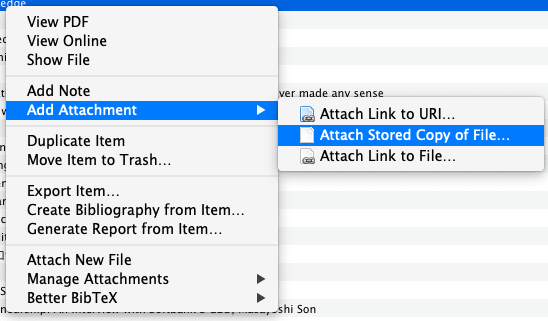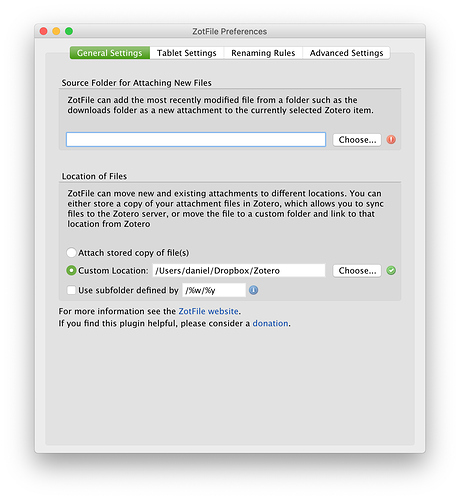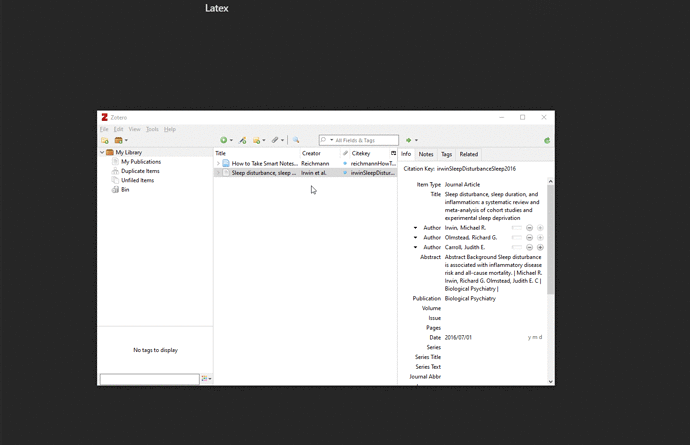If you mean the yellow Zotero notes, I don’t think it is possible. Zotfile creates new notes every time you extract new annotations, if you want to get rid of them I think deleting them manually is the only way. I think there may be use cases where people annotate/highlight the PDFs for different purposes and/or at different times, and might want to keep the old notes too.
Has anyone created at alternative copy (i.e. Quick Copy alt 1) that is specific to Markdown? Ideally I’d have it copy the [Title](zotero link) rather than just the simple Zotero link. I’ve been trying to figure out how to do this, but any pretty lost…
There you go! copy-link-to-selected-item
How are you guys avoiding special character in titles names in Zotero? I have set zotfile to replace special characters, but it seem to only do it for the filenames and not the actual title within Zotero.
@argentum Can you help me understand the role of this line of code in the zotfile .travis.yml file? I’m extra cautious about software installs, even when they’re open source.
- curl -F "file=@zotfile-build-$TRAVIS_BUILD_NUMBER.xpi" https://api.anonfile.com/upload
I only became aware of “curl” this week, and I think the idea is to use it to download/build packages. I’ve been using homebrew, and read a bit about macports, then saw a bit about curl. But what’s up with the anonfile “upload” bit? If I use zotfile, what am I uploading, if anything?
Hey @s0ph0s, let me start with the disclaimer that I’m not the Zotfile developer, so all the explanation below is just based on my experience as a dev. I also want to say that there is no reason to be worried about that line, since Travis can’t run in your computer.
Travis is a continuous integration service, that is, something you use to test and build your code, and, in Zotfile’s case, “deploy” your code. You can see how Travis executes the commands listed in that yaml file over here. They seem to be using it to upload the xpi file to the link in that line, most likely to be able to send it to people if they need to test a fix.
I don’t use Zotero, but just a plain .bib file for my references. Since Zotero users might export their data with Better Bibtex to a .bib file, too, this might be interesting to some of you (works on macOS and probably on Linux, requires certain familiarity with terminal applications):
Thank you, so this works for me now.
This part is less clear for me. I realized my pdf is now moved to ~/Zotero/storage/MCDERLHB where MCDERLHB is some kind of random name after I did a Add attachment > Add stored copy of file.

I think I want to have the pdf stored inside my obsidian vault. Do you recommend any other parts of the zotero stored inside the obsidian vault as well?
This part is less clear for me. I realized my pdf is now moved to ~/Zotero/storage/MCDERLHB where MCDERLHB is some kind of random name after I did a Add attachment > Add stored copy of file.
To use Zotfile to rename and move your files, you need to use “Manage attachments > Rename attachements”, then the file will be moved to the catalogue you chosen in the Zotfile settings (check Tools)
You shouldn’t manipulate the folder where Zotero store their database.
If you want link to pdf stored in Obsidian vault you simple attach link to that file to Zotero database.
Is there any way to get Mdnotes on windows?
@Kayamon Zotero runs on Windows too, you only need to install the plugin to Zotero as described here:
To install a plugin in Zotero, download its
.xpifile to your computer. Then, in Zotero, click “Tools → Add-Ons”, then drag the.xpifor the plugin onto the Add-Ons window that opens
You can grab the latest version here.
Hey Guys,
I have created a simple Zotero translator that creates a markdown link to your Zotero Item when quick copying (drag and dropping) the item into obsidian.
Demo
How to Install
- Download Markdown.Item.URI.js from Github
- Place file inside the “translators” directory in your Zotero data folder
- Restart Zotero
- In the Zotero Preferences go to the “Export” and set the Default Output Format to “Markdown Item URI” (this will be towards the bottom of the list)

You can now take advantage of Zotero’s quick copy functionality and drag&drop links from the item in your client right into Obsidian.
Thanks for that!! It is really helpful
SO how do you juggle your pdf files with Zotero and Obsidian?
I am looking for inspiration. My files are all over the place despite having both software. I guess I need a system.
Always a good starting point for being productive… ![]()
I don’t have my pdfs in Obsidian;
-
I use Zotfile plugin to put all my files in Zotero to one folder in dropbox to sync between computers ( I have over 5gb pdfs, so this is more than free Zotero account allows to synce )
-
Then I use this plugin from post above Zotero best practices to link the item from Zotero to Obsidian database;
-
I prefer to open my pdfs in external pdf readers
I would really really recommend using Zotfile to manage the PDFs so you don’t run into this issues. @echej summarized very well how that is possible:
More details about that here.
I can’t argue with that! My only point is that moving and relocating things in Zotero is a painful process, and for most people Zotfile will do a much better job. I’m sorry that’s not the case for you!
I don’t know what you’re referring to. Using Zotfile it’s possible to create some structure based on the wildcards it supports, and it’s possible to add some of the metadata in the filenames. It might not work for your particular use case, given that you’re using it for things other than references and other types of files, but it is also not impossible.
Having said that, there are indeed limitations (not possible to organize folders based on collections) and yes, if Zotero eventually dies, that collection “classification” will die with it.
My strategy for that is encoding everything with citekeys: I have a bib file for my entire library, so I know what the citekey is with respect to the paper. My naming convention for my notes usually includes the citekey (or links or references it). Because the export with mdnotes, I now also have information about the collections in my notes. And because my Zotfile-generated folders also have the citekey, I’m not too worried about not being able to find stuff.
Can you elaborate a bit more about this strategy? I am still exploring the ideal strategy for how to organize my small library of pdfs. So I am interested in other people’s way of doing things
Can you briefly expand a bit more on your system? My issue with typical folder hierarchy is that it kinda forces a file to only have 1 direct parent (i.e. the folder) or ancestry (i.e. the folder path)
Sometimes you come across a pdf or some document and it hits on several topics e.g. maybe an article may be related to topic A, B, and C. And also relevant to your projects X, Y, and Z.
Before Zotero and Obsidian, I wonder whether I should have a storage hierarchy independent of the topics and projects or I should simply duplicate the PDFs and put the copies in the relevant topic and project folders.
Now, I am thinking of just having a flat folder hierarchy to store the PDFs and yet remain accessible to Zotero and/or Zotfile. Then perhaps using @argentum plugin for mdnotes create a md reference to that PDF. Then the individual markdown notes for topic A, B, C, and projects X, Y, Z, all have links to the md note of that PDF.
So your experience may help me decide one way or another. Or perhaps even another completely different way of organizing

